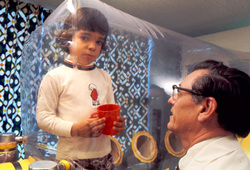Pathology definition - Severe Combined Immunodeficiency Disease ( SCID)

Severe combined immunodeficiency disease ( SCID)
Severe combined immunodeficiency disease or SCID may present with recurrent infection by P. carinii, pseudomonas, candida albicans, cytoomegalovirus and varicella zoster virus ( bacteria, fungal and viral infection).
Patient with severe combined immunodeficiency disease may present with thrush, diaper rash and failure to thrive.
Severe combined immunodeficiency may present with hypolastic of the lymphoid tissue, depletion of the areas of the T cells and the present of small undifferentiated thymus as well as reduced lymphocytes. Patient may suffer from lymphopenia.
Severe combined immunodeficiency is a X linked recessive disorder and in some case is autosomal recessive disorders. Severe combined immunodeficiency disease may occur due to defect in IL - 2 receptors on T cells or deficiency of tyrosine kinase and adenosine deaminase and failure to synthesizes class II MHC antigen or mutation of the recombinase gene. These condition may results in defect of the differentiation of the stem cell which finally impair the cell mediated immune response and humoral immune response.
The treatment for severe combined immunodeficiency disease include stem cell transplantation, bone marrow transplantation and transplantation of the adenosine deaminase gene.
Severe combined immunodeficiency disease or SCID may present with recurrent infection by P. carinii, pseudomonas, candida albicans, cytoomegalovirus and varicella zoster virus ( bacteria, fungal and viral infection).
Patient with severe combined immunodeficiency disease may present with thrush, diaper rash and failure to thrive.
Severe combined immunodeficiency may present with hypolastic of the lymphoid tissue, depletion of the areas of the T cells and the present of small undifferentiated thymus as well as reduced lymphocytes. Patient may suffer from lymphopenia.
Severe combined immunodeficiency is a X linked recessive disorder and in some case is autosomal recessive disorders. Severe combined immunodeficiency disease may occur due to defect in IL - 2 receptors on T cells or deficiency of tyrosine kinase and adenosine deaminase and failure to synthesizes class II MHC antigen or mutation of the recombinase gene. These condition may results in defect of the differentiation of the stem cell which finally impair the cell mediated immune response and humoral immune response.
The treatment for severe combined immunodeficiency disease include stem cell transplantation, bone marrow transplantation and transplantation of the adenosine deaminase gene.
